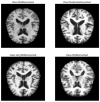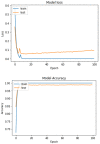Accurate Detection of Alzheimer's Disease Using Lightweight Deep Learning Model on MRI Data
- PMID: 37046434
- PMCID: PMC10093003
- DOI: 10.3390/diagnostics13071216
Accurate Detection of Alzheimer's Disease Using Lightweight Deep Learning Model on MRI Data
Abstract
Alzheimer's disease (AD) is a neurodegenerative disorder characterized by cognitive impairment and aberrant protein deposition in the brain. Therefore, the early detection of AD is crucial for the development of effective treatments and interventions, as the disease is more responsive to treatment in its early stages. It is worth mentioning that deep learning techniques have been successfully applied in recent years to a wide range of medical imaging tasks, including the detection of AD. These techniques have the ability to automatically learn and extract features from large datasets, making them well suited for the analysis of complex medical images. In this paper, we propose an improved lightweight deep learning model for the accurate detection of AD from magnetic resonance imaging (MRI) images. Our proposed model achieves high detection performance without the need for deeper layers and eliminates the use of traditional methods such as feature extraction and classification by combining them all into one stage. Furthermore, our proposed method consists of only seven layers, making the system less complex than other previous deep models and less time-consuming to process. We evaluate our proposed model using a publicly available Kaggle dataset, which contains a large number of records in a small dataset size of only 36 Megabytes. Our model achieved an overall accuracy of 99.22% for binary classification and 95.93% for multi-classification tasks, which outperformed other previous models. Our study is the first to combine all methods used in the publicly available Kaggle dataset for AD detection, enabling researchers to work on a dataset with new challenges. Our findings show the effectiveness of our lightweight deep learning framework to achieve high accuracy in the classification of AD.
Keywords: Alzheimer’s disease; Kaggle dataset; MRI data; deep learning; detection; lightweight model.
Conflict of interest statement
The authors declare no conflict of interest.
Figures












References
-
- Chassain C., Cladiere A., Tsoutsos C., Pereira B., Boumezbeur F., Debilly B., Marques A.-R., Thobois S., Durif F. Evaluation of Common and Rare Variants of Alzheimer’s Disease-Causal Genes in Parkinson’s Disease. Park. Relat. Disord. 2022;97:8–14. doi: 10.1016/j.parkreldis.2022.05.007. - DOI - PubMed
-
- Sarasso E., Gardoni A., Piramide N., Volontè M.A., Canu E., Tettamanti A., Filippi M., Agosta F. A Multiparametric MRI Study of Structural Brain Damage in Dementia with Lewy Bodies: A Comparison with Alzheimer’s Disease. Park. Relat. Disord. 2021;91:154–161. doi: 10.1016/j.parkreldis.2021.09.003. - DOI - PubMed
Grants and funding
LinkOut - more resources
Full Text Sources

